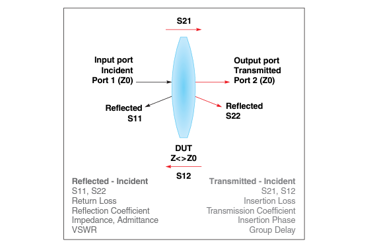S-Parameters For High-frequency Circuit Simulations

Scattering parameters (S-parameters) are frequencydomain reflection-transmission measurements, or models, that are used to simulate inductors, wideband transformers, and common mode chokes at RF and microwave frequencies.
S-parameters can accelerate the simulation process by placing a single “black box” element into a schematic and pointing to a file. This avoids having to create complicated lumped-element (SPICE) model schematics that only approximate distributed characteristics. While easier to set up in simulation, users should understand the challenges and limitations of using S-parameters before analyzing simulation results. In this note, we will discuss the basics of S-parameters and when they are appropriate for circuit simulation.
What are S-parameters?
S-parameters are a complex matrix of numerical values typically arranged in the standard Touchstone format. The Touchstone format is a defacto industry standard that facilitates measurement and simulation using any instrument or simulation program that uses S-parameters. Touchstone parameters may be in an amplitude (magnitude) and phase (angle) format, or in a transmission and reflection coefficient S-parameter format. A 2-port device has (22=) four S-parameters, 3-port has (32 =) nine S-parameters, and a 4-port device has (42 =) sixteen S-parameters at each measured frequency. To distinguish the number of ports easily, Touchstone files use a file extension naming convention of .SNP where N is the number of ports (e.g. 2-port files end in .S2P, 3-port end in .S3P, etc.).
Get unlimited access to:
Enter your credentials below to log in. Not yet a member of RF Globalnet? Subscribe today.
